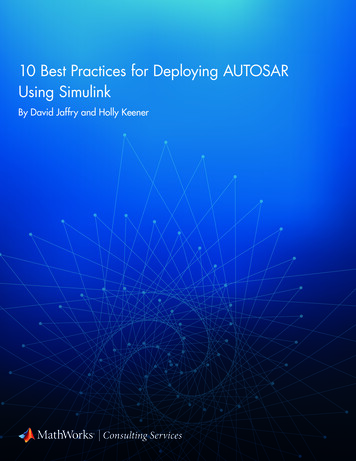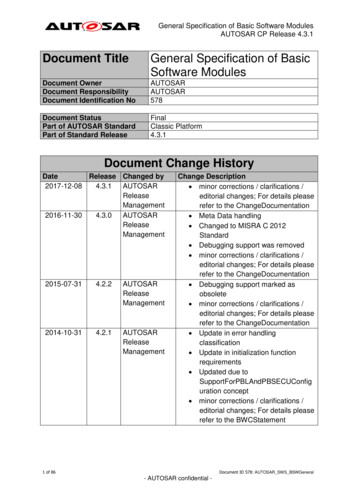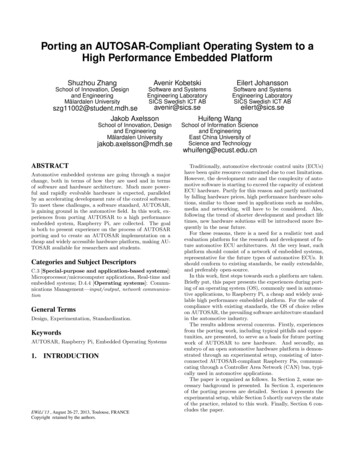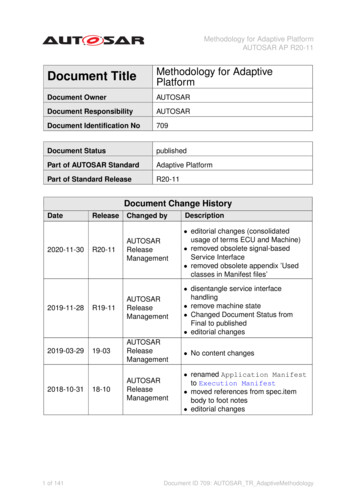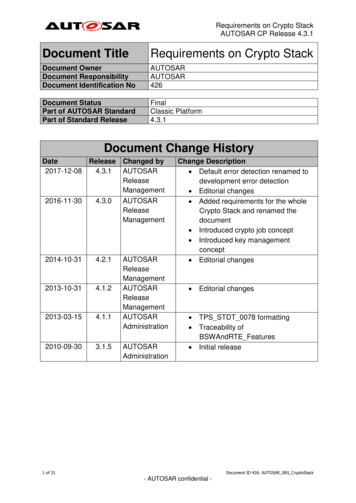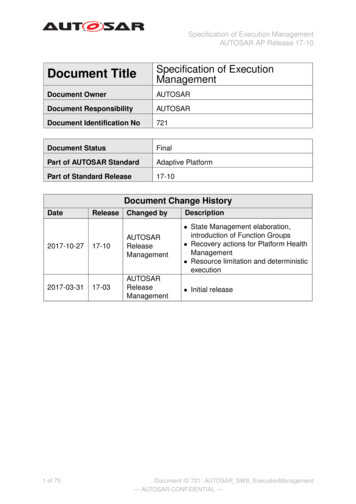
Transcription
Specification of Execution ManagementAUTOSAR AP Release 17-10Document TitleSpecification of ExecutionManagementDocument OwnerAUTOSARDocument ResponsibilityAUTOSARDocument Identification No721Document StatusFinalPart of AUTOSAR StandardAdaptive PlatformPart of Standard Release17-10Document Change HistoryDateReleaseChanged nt State Management elaboration,introduction of Function Groups Recovery actions for Platform HealthManagement Resource limitation and eManagement Initial release1 of 75Document ID 721: AUTOSAR SWS ExecutionManagement— AUTOSAR CONFIDENTIAL —
Specification of Execution ManagementAUTOSAR AP Release 17-10DisclaimerThis work (specification and/or software implementation) and the material contained init, as released by AUTOSAR, is for the purpose of information only. AUTOSAR and thecompanies that have contributed to it shall not be liable for any use of the work.The material contained in this work is protected by copyright and other types of intellectual property rights. The commercial exploitation of the material contained in thiswork requires a license to such intellectual property rights.This work may be utilized or reproduced without any modification, in any form or byany means, for informational purposes only. For any other purpose, no part of the workmay be utilized or reproduced, in any form or by any means, without permission inwriting from the publisher.The work has been developed for automotive applications only. It has neither beendeveloped, nor tested for non-automotive applications.The word AUTOSAR and the AUTOSAR logo are registered trademarks.2 of 75Document ID 721: AUTOSAR SWS ExecutionManagement— AUTOSAR CONFIDENTIAL —
Specification of Execution ManagementAUTOSAR AP Release 17-10Table of Contents1 Introduction and functional overview1.11.26What is Execution Management? . . . . . . . . . . . . . . . . . . . . .Interaction with AUTOSAR Runtime for Adaptive . . . . . . . . . . . .662 Acronyms and abbreviations73 Related documentation83.13.23.3Input documents . . . . . . . . . . . . . . . . . . . . . . . . . . . . . .Related standards and norms . . . . . . . . . . . . . . . . . . . . . . .Related specification . . . . . . . . . . . . . . . . . . . . . . . . . . . .4 Constraints and assumptions4.14.29Known limitations . . . . . . . . . . . . . . . . . . . . . . . . . . . . . .Applicability to car domains . . . . . . . . . . . . . . . . . . . . . . . .5 Dependencies to other modules5.15.28889910Platform dependencies . . . . . . . . . . . . . . . . . . . . . . . . . . .Other dependencies . . . . . . . . . . . . . . . . . . . . . . . . . . . .10106 Requirements tracing117 Functional specification137.17.27.37.47.53 of 75Technical Overview . . . . . . . . . . . . .7.1.1Application . . . . . . . . . . . .7.1.2Adaptive Application . . . . . . .7.1.3Executable . . . . . . . . . . . .7.1.4Process . . . . . . . . . . . . . .7.1.5Application Manifest . . . . . . .7.1.6Machine Manifest . . . . . . . .7.1.7Manifest format . . . . . . . . .Execution Management Responsibilities .Platform Lifecycle Management . . . . . .Application Lifecycle Management . . . .7.4.1Process States . . . . . . . . . .7.4.2Startup and shutdown . . . . . .7.4.3Startup sequence . . . . . . . .7.4.3.1Application dependencyState Management . . . . . . . . . . . . .7.5.1Overview . . . . . . . . . . . . .7.5.2Application State . . . . . . . . .7.5.3Machine State . . . . . . . . . .7.5.3.1Startup . . . . . . . . .7.5.3.2Shutdown . . . . . . . .7.5.3.3Restart . . . . . . . . .7.5.4Function Group State . . . . . ument ID 721: AUTOSAR SWS ExecutionManagement— AUTOSAR CONFIDENTIAL —
Specification of Execution ManagementAUTOSAR AP Release 17-107.5.57.67.77.87.9State Management Architecture . . . . .7.5.5.1State Manager . . . . . . . . . .7.5.5.2State Interaction . . . . . . . . .7.5.6State Change . . . . . . . . . . . . . . .Application Recovery Actions . . . . . . . . . . . .7.6.1Overview . . . . . . . . . . . . . . . . . .7.6.2Recovery Actions Interfaces . . . . . . .7.6.3Integrated in the Execution ManagementResources and Deterministic Execution . . . . . .7.7.1Introduction . . . . . . . . . . . . . . . . .7.7.1.1Resource Configuration . . . . .7.7.1.2Resource Monitoring . . . . . . .7.7.1.3Deterministic Execution . . . . .7.7.2Resource configuration and monitoring .7.7.2.1CPU usage . . . . . . . . . . . .7.7.2.2Memory Budget and Monitoring .Deterministic Redundant Execution . . . . . . . . .7.8.1Redundant Execution Overview . . . . .7.8.2Redundant Execution Example . . . . . .7.8.3Redundant Execution Details . . . . . . .Handling of Application Manifest . . . . . . . . . .7.9.1Overview . . . . . . . . . . . . . . . . . .7.9.2Application Dependency . . . . . . . . .7.9.3Application Arguments . . . . . . . . . .7.9.4Machine State and Function Group State7.9.5Scheduling Policy . . . . . . . . . . . . .7.9.6Scheduling Priority . . . . . . . . . . . . .7.9.7Application Binary Name . . . . . . . . .8 API specification8.159Type definitions . . . . . . . . . . . . . . . . . . . . . . . . .8.1.1ApplicationState . . . . . . . . . . . . . . . . . . .8.1.2ApplicationReturnType . . . . . . . . . . . . . . .8.1.3StateReturnType . . . . . . . . . . . . . . . . . . .8.1.4RecoveryActionReturnType . . . . . . . . . . . . .8.1.5ResetCause . . . . . . . . . . . . . . . . . . . . .8.2Class definitions . . . . . . . . . . . . . . . . . . . . . . . .8.2.1ApplicationClient class . . . . . . . . . . . . . . .8.2.1.1ApplicationClient::ApplicationClient . . . .8.2.1.2ApplicationClient:: ApplicationClient . . .2.1.4ApplicationClient::SetLastResetCause . .8.2.1.5ApplicationClient::GetLastResetCause . .8.2.2StateClient class . . . . . . . . . . . . . . . . . . .8.2.2.1StateClient::StateClient . . . . . . . . . .8.2.2.2StateClient:: StateClient . . . . . . . . . .4 of 57575858.59595959606061616162626263636464Document ID 721: AUTOSAR SWS ExecutionManagement— AUTOSAR CONFIDENTIAL —
Specification of Execution ManagementAUTOSAR AP Release 17-108.2.2.3StateClient::GetState . . . . . . . . . . . . . .8.2.2.4StateClient::SetState . . . . . . . . . . . . . .8.2.3RecoveryActionClient class . . . . . . . . . . . . . . 8.2.3.2RecoveryActionClient:: estartProcess . . . .8.2.3.4RecoveryActionClient::OverrideState . . . . .9 Service Interfaces65666868686969709.1Service Type definitions . .9.1.1State StatusType9.2State Management Interface9.2.1Methods . . . . .9.2.2Events . . . . . .7070707071A Not applicable requirements72B Mentioned Class Tables725 of 75Document ID 721: AUTOSAR SWS ExecutionManagement— AUTOSAR CONFIDENTIAL —
Specification of Execution ManagementAUTOSAR AP Release 17-101Introduction and functional overviewThis document is the software specification of the Execution Management functional cluster within the Adaptive Platform.Execution Management is responsible for all aspects of system execution management including platform initialization and startup / shutdown of Applications. Execution Management works in conjunction with the Operating System to performrun-time scheduling of Applications. This document describes how these conceptsare realized within the Adaptive Platform. Furthermore, the Application Programming Interface (API) of the Execution Management is specified.1.1What is Execution Management?Execution Management is responsible for the startup and shutdown of Applications based on Manifest information. The usage of Execution Management islimited to the Adaptive Platform, however the latter is usually not exclusively usedwithin a single AUTOSAR System. The vehicle is also equipped with a number of ECUs developed on the AUTOSAR Classic Platform and the system design for the entirevehicle will therefore have to cover both ECUs built using that as well as the AdaptivePlatform.1.2Interaction with AUTOSAR Runtime for AdaptiveThe Execution Management is a functional cluster contained in the AdaptivePlatform Foundation. The set of programming interfaces to the Adaptive Applications is called ARA.Execution Management, in common with other Applications is assumed to be aprocess executed on a POSIX compliant operating system. Execution Managementis responsible for initiating execution of the processes in all the Functional Clusters,Adaptive AUTOSAR Services, and Adaptive Applications. The launching ordermust be given to the Execution Management according to the specification definedin this document to ensure proper startup of the system.The Adaptive AUTOSAR Services are provided via the Communication Management functional cluster of the Adaptive Platform Foundation. In order to use theAdaptive AUTOSAR Services, the functional clusters in the Foundation must be properly initialized beforehand. Refer to the respective specifications regarding more information on the Communication Management.6 of 75Document ID 721: AUTOSAR SWS ExecutionManagement— AUTOSAR CONFIDENTIAL —
Specification of Execution ManagementAUTOSAR AP Release 17-102Acronyms and abbreviationsAll technical terms used throughout this document – except the ones listed here – canbe found in the official [1, AUTOSAR glossary] or [2, TPS Manifest Specification].TermProcessApplication DependencyExecution ManagementState ManagerMachine StateFunction Group StateTime DeterminismData DeterminismFull DeterminismDescriptionA process is a loaded instance of an Executable to be executedon a Machine.Dependencies between Executable instances can be configured to define a sequence for starting and terminating them.The element of the Adaptive Platform responsible for theordered startup and shutdown of the Adaptive Platform andthe Applications.The element of the Execution Management defining modes ofoperation for Adaptive Platform. It allows flexible definitionof functions which are active on the platform at any given time.Architecture and functionality of State Management are still underdicussion. A consolidated description will follow in a later release.The element of the State Management which characterize thecurrent status of the machine. It defines a set of active Applications for any certain situation. The set of Machine Statesis machine specific and it will be deployed in the Machine Manifest. Machine States are mainly used to control machinelifecycle (startup/shut-down/restart) and platform-level processes.The element of the State Management which characterize thecurrent status of functionally coherent user-level Applications.The set of Function Groups and their Function Group States is machine specific and it will be deployed in the MachineManifest.The results of a calculation are guaranteed to be available beforea given deadline.The results of a calculation only depend on the input data andare reproducible, assuming a given initial internal state.Combination of Time and Data Determinism.Table 2.1: Technical Terms7 of 75Document ID 721: AUTOSAR SWS ExecutionManagement— AUTOSAR CONFIDENTIAL —
Specification of Execution ManagementAUTOSAR AP Release 17-103Related documentation3.1Input documentsThe main documents that serve as input for the specification of the Execution Management are:[1] GlossaryAUTOSAR TR Glossary[2] Specification of ManifestAUTOSAR TPS ManifestSpecification[3] Requirements on Operating System InterfaceAUTOSAR RS OperatingSystemInterface[4] Requirements on Execution ManagementAUTOSAR RS ExecutionManagement[5] Methodology for Adaptive PlatformAUTOSAR TR AdaptiveMethodology[6] Standard for Information Technology–Portable Operating System Interface(POSIX(R)) Base Specifications, Issue .2Related standards and normsSee chapter 3.1.3.3Related specificationSee chapter 3.1.8 of 75Document ID 721: AUTOSAR SWS ExecutionManagement— AUTOSAR CONFIDENTIAL —
Specification of Execution ManagementAUTOSAR AP Release 17-104Constraints and assumptions4.1Known limitationsThis chapter lists known limitations of Execution Management and their relation tothis release of the Adaptive Platform. The intent is to not only provide a specification of the current state of Execution Management but also an indication how theAdaptive Platform will evolve future releases.The following functionality is mentioned within this document but is not fully specifiedin this release: Appendix A details requirements from Execution Management Requirement Specification that are not elaborated within this specification. The presenceof these requirements in this document ensures that the requirement tracing iscomplete and also provides an indication of how Execution Management willevolve in future releases of the Adaptive Platform. Resource limitation and deterministic execution will be expanded with more properties and formal requirements (see 7.7 and 7.8). ECU/VM reset needs more clarification. Error handling and timeout is not finished and will be expanded.The functionality described above is subject to modification and will be considered forinclusion in a future release of this document.4.2Applicability to car domainsNo restrictions to applicability.9 of 75Document ID 721: AUTOSAR SWS ExecutionManagement— AUTOSAR CONFIDENTIAL —
Specification of Execution ManagementAUTOSAR AP Release 17-1055.1Dependencies to other modulesPlatform dependenciesOperating System InterfaceThe Execution Management functional cluster is dependent on the Operating System Interface [3]. The OSI is used by Execution Management to control specificaspects of Application execution. E.g. to set scheduling parameters or to executean Application.5.2Other dependenciesCurrently, there are no other library dependencies.10 of 75Document ID 721: AUTOSAR SWS ExecutionManagement— AUTOSAR CONFIDENTIAL —
Specification of Execution ManagementAUTOSAR AP Release 17-106Requirements tracingThe following tables reference the requirements specified in [4] and links to the fulfillment of these. Please note that if column “Satisfied by” is empty for a specific requirement this means that this requirement is not fulfilled by this document.Requirement[RS EM 00002][RS EM 00003][RS EM 00004][RS EM 00005][RS EM 00006][RS EM 00007][RS EM 00008][RS EM 00009][RS EM 00010][RS EM 00011][RS EM 00012][RS EM 00013]11 of 75DescriptionThe Execution Managementshall set-up one process for theexecution of each ExecutableinstanceThe Execution Managementshall support the checking of theintegrity of Executables atstartup of Executable.The Execution Managementshall support the authenticationand authorization of Executablesat startup of ExecutableThe Execution Managementshall support the configuration ofOS resource budgets forExecutable and groups ofExecutablesThe Execution Managementshall support the supervision ofavailable and required OSresource budgets forExecutables and groups ofExecutables during installationThe Execution Managementshall support allocation ofdedicated resources for theExecutable (e.g GPU)The Execution Managementshall support the binding ofExecutable threads to aspecified set of processor cores.Only Execution Managementshall start ExecutablesThe Execution Managementshall support multiple instancesof ExecutablesExecution Managemen shallsupport self-initiated gracefulshutdown of ExecutableinstancesApplication Manifes shallsupport unique identification ofExecutable instancesExecution Management shallsupport configurable recoveryactionsSatisfied by[SWS EM 01014] [SWS EM 01015][SWS EM 01039] [SWS EM 01040][SWS EM 01041] [SWS EM 01042][SWS EM 01043][SWS EM NA][SWS EM NA][SWS EM NA][SWS EM NA][SWS EM NA][SWS EM 01201][SWS EM 01030][SWS EM 01012] [SWS EM 01033][SWS EM 01005][SWS EM 01017] [SWS EM 01050][SWS EM 01016] [SWS EM 01018][SWS EM 01061] [SWS EM 01062]Document ID 721: AUTOSAR SWS ExecutionManagement— AUTOSAR CONFIDENTIAL —
Specification of Execution ManagementAUTOSAR AP Release 17-10Requirement[RS EM 00050][RS EM 00051][RS EM 00052][RS EM 00053][RS EM 00100][RS EM 00101]DescriptionThe Execution Managemen shalldo a system-wide coordinationof activitiesThe Execution Managementshall provide functions to theExecutable for configuringexternal trigger conditions for itsactivitiesThe Execution Managementshall provide functions to theExecutable for configuring cyclictriggering of its activitiesThe Execution Managementshall provide functions tosupport redundant execution ofExecutablesThe Execution Managementshall support the ordered startupand shutdown of ExecutablesThe Execution Managementshall provide State Managementfunctionality[RS EM 00103]Execution Management shallsupport application lifecyclemanagement[RS EM 00110]Execution Management shallsupport diagnostic reset cause12 of 75Satisfied by[SWS EM NA][SWS EM NA][SWS EM NA][SWS EM NA][SWS EM 01000] [SWS EM 01001][SWS EM 01050] [SWS EM 01051][SWS EM 01013] [SWS EM 01023][SWS EM 01024] [SWS EM 01025][SWS EM 01026] [SWS EM 01028][SWS EM 01032] [SWS EM 01034][SWS EM 01035] [SWS EM 01036][SWS EM 01037] [SWS EM 01056][SWS EM 01058] [SWS EM 01059][SWS EM 01060] [SWS EM 01107][SWS EM 01108] [SWS EM 01109][SWS EM 01110] [SWS EM 01111][SWS EM 01112] [SWS EM 02005][SWS EM 02006] [SWS EM 02007][SWS EM 02008] [SWS EM 02031][SWS EM 02044] [SWS EM 02047][SWS EM 02048] [SWS EM 02049][SWS EM 02050] [SWS EM 02051][SWS EM 02054] [SWS EM 02055][SWS EM 02056] [SWS EM 02057][SWS EM 02070] [SWS EM 02072][SWS EM 02073] [SWS EM 02074][SWS EM 02075][SWS EM 01002] [SWS EM 01003][SWS EM 01004] [SWS EM 01005][SWS EM 01006] [SWS EM 01053][SWS EM 01055] [SWS EM 02000][SWS EM 02001] [SWS EM 02002][SWS EM 02003] [SWS EM 02030][SWS EM 02031] [SWS EM 02071][SWS EM 02041] [SWS EM 02042][SWS EM 02043]Document ID 721: AUTOSAR SWS ExecutionManagement— AUTOSAR CONFIDENTIAL —
Specification of Execution ManagementAUTOSAR AP Release 17-1077.1Functional specificationTechnical OverviewThis chapter presents a short summary of the relationship between Application,Executable, and Process.7.1.1ApplicationApplications are developed to resolve a set of coherent functional requirements.An Application consists of executable software units, additional execution relateditems (e.g. data or parameter files), and descriptive information used for integrationend execution (e.g. a formal model description based on the AUTOSAR meta model,test cases).Applications can be located on user level above the middleware or can implementfunctional clusters of the Adaptive Platform (located on the level of the middleware), see [TPS MANI 01009] in [2].Applications might use all mechanisms and APIs provided by the operating systemand other functional clusters of the Adaptive Platform, which in general restrictsportability to other Adaptive Platforms.All Applications, including Adaptive Applications (see below), are treated thesame by Execution Management.7.1.2Adaptive ApplicationAn Adaptive Application is a specific type of Application. The implementation of an Adaptive Application fully complies with the AUTOSAR specification,i.e. it is restricted to use APIs standardized by AUTOSAR and needs to follow specificcoding guidelines to allow reallocation between different Adaptive Platforms.Adaptive Applications are always located above the middleware. To allow portability and reuse, user level Applications should be Adaptive Applicationswhenever technically possible.Figure 7.1 shows the different types of Applications.13 of 75Document ID 721: AUTOSAR SWS ExecutionManagement— AUTOSAR CONFIDENTIAL —
Specification of Execution ManagementAUTOSAR AP Release 17-10non portable, e.g.hardware-dependentuser icationuser levelplatform/machinetypicalfunctional nfully AUTOSARcompliantreusableplatformApplicationFigure 7.1: Types of ApplicationsAn Adaptive Application is the result of functional development and is the unit ofdelivery for Machine specific configuration and integration. Some contracts (e.g. concerning used libraries) and Service Interfaces to interact with other Adaptive Applications need to be agreed on beforehand. For details see [5].7.1.3ExecutableAn Executable is a software unit which is part of an Application. It has exactlyone entry point (main function), see [SWS OSI 01300]. An Application can beimplemented in one or more Executables.The lifecycle of Executables usually consists of:Process StepDevelopmentand IntegrationSoftwareLinked, configured and calibrated binary for deployment onto the targetMachine. The binary might containcode which was generated at integration time.Deploymentand RemovalBinary installed on the target Machine.ExecutionProcess started as instance of the binary.Meta InformationApplication Manifest,see7.1.5 and [2], and Service Instance Manifest (not used byExecution Management).Processed Manifests, stored in aplatform-specific format which is efficiently readable at Machine startup.The Execution Management usescontents of the Processed Manifests to start up and configure each process individually.Table 7.1: Executable Lifecycle14 of 75Document ID 721: AUTOSAR SWS ExecutionManagement— AUTOSAR CONFIDENTIAL —
Specification of Execution ManagementAUTOSAR AP Release 17-10Executables which belong to the same Adaptive Application might need to bedeployed to different Machines, e.g. to one high performance Machine and one highsafety Machine.Figure 7.2 shows the lifecycle of an Executable from deployment to execution.Figure 7.2: Executable Lifecycle from deployment to executionRemark: Throughout this document, on execution level the term Application refersto one Executable of this Application, i.e. whenever mechanism on the Machineor contents of the Application Manifest are described, there is no distinctionbetween Application and Executable, because the Application componentmodel is flattened into independent Executables after deployment.7.1.4ProcessA Process is a started instance of an Executable. For details on how ExecutionManagement starts and stops Processes see 7.4.Remark: In this release of this document it is assumed, that processes are selfcontained, i.e. that they take care of controlling thread creation and scheduling by calling APIs from within the code. Execution Management only starts and terminatesthe processes and while the processes are running, Execution Management onlyinteracts with the processes by using State Management mechanisms (see 7.5).15 of 75Document ID 721: AUTOSAR SWS ExecutionManagement— AUTOSAR CONFIDENTIAL —
Specification of Execution ManagementAUTOSAR AP Release 17-107.1.5Application ManifestThe Application Manifest consists of parts of the Application design information which is provided by the application developer in an application description, andadditional machine-specific information which is added at integration time. For detailson the Application Manifest contents see chapter 7.9. A formal specification canbe found in [2].An Application Manifest is created together with a Service Instance Manifest (not used by Execution Management) at integration time and deployed onto aMachine together with the Executable it is attached to. It describes in a standardized way the machine-specific configuration of Process properties (startup parameters,resource group assignment, priorities etc.).Each instance of an Executable binary, i.e. each started process, is individually configurable, with the option to use a different configuration set per MachineState or per Function Group State (see 7.5 and [TPS MANI 01012], [TPS MANI 01013], [TPS MANI 01014], [TPS MANI 01015], [TPS MANI 01059], [TPS MANI 01017] and [TPS MANI 01041]).7.1.6Machine ManifestThe Machine Manifest is also created at integration time for a specific Machineand is deployed like Application Manifests whenever its contents change. TheMachine Manifest holds all configuration information which cannot be assigned toa specific Executable, i.e. which is not already covered by an Application Manifest or a Service Instance Manifest.The contents of a Machine Manifest includes the configuration of Machine properties and features (resources, safety, security, etc.), e.g. configured Machine States and Function Group States, resource groups, access right groups, scheduler configuration, SOME/IP configuration, memory segmentation. For details see [2].7.1.7Manifest formatThe Application Manifests and the Machine Manifest can be transformedinto a platform-specific format (called Processed Manifest), which is efficiently readable at Machine startup. The format transformation can be done either off board atintegration time or at deployment time, or on the Machine (by SW Configuration Management) at installation time.16 of 75Document ID 721: AUTOSAR SWS ExecutionManagement— AUTOSAR CONFIDENTIAL —
Specification of Execution ManagementAUTOSAR AP Release 17-107.2Execution Management ResponsibilitiesExecution Management is responsible for all aspects of Adaptive Platform execution management and Application execution management including:1. Platform Lifecycle ManagementExecution Management is started as part of the Adaptive Platform startup phase and is responsible for the initialization of the Adaptive Platformand deployed Applications.During execution, Execution Management monitors the Adaptive Platform and, when required, the ordered shutdown of the Adaptive Platform.2. Application Lifecycle Management – the Execution Management is responsible for the ordered startup and shutdown of the deployed Applications.The Execution Management determines when, and possibly in which order, tostart or stop the deployed Applications, based on information in the MachineManifest and Application Manifests.Depending on the Machine State or on a Function Group State, deployed Applications are started during Adaptive Platform startup or later,however it is not expected that all will begin active work immediately since manyApplications will provide services to other Applications and therefore waitand “listen” for incoming service requests.The Execution Management derives an ordering for startup/shutdown withinthe State Management framework, based on declared Application dependencies. The dependencies are described in the Application Manifests, see[TPS MANI 01041].The Execution Management is not responsible for run-time scheduling of Applications since this is the responsibility of the Operating System. However the Execution Management is responsible for initialization / configuration of the OS to enableit to perform the necessary run-time scheduling based on information extracted by theExecution Management from the Machine Manifest and Application Manifests.7.3Platform Lifecycle ManagementThe Execution Management controls the ordered startup and shutdown of theAdaptive Platform. The Platform Lifecycle Management characterize differentstages of the Adaptive Platform including:Platform startup – the Execution Manager as part of Execution Management is started as the “init” process by the Operating System and then takes overresponsibility for subsequent initialization of the Adaptive Platform and deployed Application Executables.17 of 75Document ID 721: AUTOSAR SWS ExecutionManagement— AUTOSAR CONFIDENTIAL —
Specification of Execution ManagementAUTOSAR AP Release 17-10[SWS EM 01030] Start of Application execution d Execution Management shall be solely responsible for initiating execution of Applications. c(RS EM 00009)Note that [SWS EM 01030] is exclusive; once the Execution Manager is running no other element of Adaptive Platform initiates Application execution.Platform monitoring – the Execution Management can perform Applicationmonitoring, also in conjunction with the Platform Health Management. Particular design aspects of resource monitoring are shown in chapter 7.7.Platform shutdown – the Execution Manager performs the ordered shutdown ofthe Adaptive Platform based on the dependencies, with the exception thatalready terminated Applications do not represent an error in the order.7.4Application Lifecycle Management7.4.1Process StatesFrom the execution stand point, Process States characterize the lifecycle of any Application Executable. Note that each instance (i.e. process) of an ApplicationExecutable is independent and therefore has its own Process State.[SWS EM 01002] Idle Process State d The Idle Process State shall be the Process state prior to creation of the Applications process and resource allocation. c(RS EM 00103)[SWS EM 01003] Starting Process State d The Starting Process State shall applywhen the Application’s process has been created and resources have been allocated. c(RS EM 00103)[SWS EM 01004] Running Process State d The Running Process State shall apply to an Applications process after it has been scheduled and it has reportedRunning State to the Execution Manag
Adaptive AUTOSAR Services, and Adaptive Applications. The launching order must be given to the Execution Management according to the specification defined in this document to ensure proper startup of the system. The Adaptive AUTOSAR Services are provided via the Communication Managemen-t functional cluster of the Adaptive Platform Foundation.


